Decoupling of Water Production and Electricity Generation from GDP and Population in the Gulf Cooperation Council (GCC) Countries
Abstract
:1. Introduction
2. Literature Review
3. Materials and Methods
3.1. Study Areas: GCC, KSA, UAE, and the Emirate of Abu Dhabi
3.2. Influencing Factors of Water Production and Electricity Generation—Abu Dhabi
3.3. Trend Analysis of Water and Electricity Consumptions—Abu Dhabi
3.4. GDP, Water Production, and Electricity Generation—Comparison between UAE and KSA
4. Results
4.1. Influencing Factors on Water and Electricity Demand in Abu Dhabi
4.2. Trend Analysis of Water and Electricity Consumption in Abu Dhabi
4.3. Effects of GDP on Water Production and Electricity Generation—GCC, UAE, and KSA
5. Discussion
5.1. Decoupling of Water Production and Electricity Generation from GDP and Population—Abu Dhabi
5.2. Oil Price and Fuel Cost
5.3. Electricity Supply and Water Consumption—Abu Dhabi
5.4. Decoupling of Electricity and Water—Abu Dhabi
5.5. GCC, KSA, and UAE GDP, Water, and Electricity Relations
5.6. Limitation of the Study
6. Conclusions
Author Contributions
Funding
Institutional Review Board Statement
Informed Consent Statement
Data Availability Statement
Acknowledgments
Conflicts of Interest
Appendix A
| Activities | 2011 | 2012 | 2013 | 2014 | 2015 |
|---|---|---|---|---|---|
| Total | 641,831 | 672,668 | 702,941 | 733,825 | 779,984 |
| Total Nonoil | 302,256 | 320,052 | 339,120 | 368,060 | 395,997 |
| Agriculture, forestry, and fishing | 5006 | 5264 | 5383 | 5468 | 5755 |
| Mining and quarrying (includes crude oil and natural gas) | 339,575 | 352,615 | 363,821 | 365,765 | 383,987 |
| Manufacturing | 37,830 | 38,319 | 40,090 | 42,843 | 47,655 |
| Electricity, gas, and water supply; waste management activities | 16,798 | 18,076 | 18,589 | 20,514 | 23,386 |
| Construction | 83,759 | 85,077 | 85,545 | 89,738 | 93,807 |
| Wholesale and retail trade; repair of motor vehicles and motorcycles | 23,315 | 24,719 | 26,705 | 29,502 | 32,476 |
| Transportation and storage | 18,739 | 20,598 | 22,042 | 23,820 | 25,452 |
| Accommodation and food services | 7314 | 7428 | 7921 | 8429 | 8979 |
| Information and communication | 18,808 | 18,409 | 18,469 | 20,692 | 21,779 |
| Financial and insurance activities | 27,462 | 33,043 | 44,886 | 53,042 | 57,953 |
| Real estate activities | 27,384 | 31,810 | 31,757 | 37,167 | 41,245 |
| Professional, scientific, and technical | 15,761 | 14,930 | 15,137 | 15,502 | 15,745 |
| Administration and support services | 7932 | 7952 | 8037 | 8588 | 9216 |
| Public administration and defense | 20,738 | 23,991 | 28,327 | 29,748 | 30,090 |
| Education | 7287 | 7385 | 7748 | 8103 | 8440 |
| Human health and social work | 3612 | 5114 | 6800 | 7505 | 8047 |
| Art, recreation, and other services | 2146 | 2295 | 1940 | 1955 | 2024 |
| Activities of households as employers | 1470 | 1695 | 2583 | 3153 | 3664 |
| Imputed bank services | −23,102 | −26,053 | −32,842 | −37,705 | −39,716 |
| Activities | 2011 | 2012 | 2013 | 2014 | 2015 |
|---|---|---|---|---|---|
| GDP at constant 2007 prices (million AED) | 641,831 | 672,668 | 702,941 | 733,825 | 779,984 |
| GDP at constant 2007 prices (annual % change) | 9.3 | 4.8 | 4.5 | 4.4 | 6.3 |
| Oil value added at constant 2007 prices (million AED) | 339,575 | 352,615 | 363,821 | 365,765 | 383,987 |
| Oil value added at constant 2007 prices (annual % change) | 11.7 | 3.8 | 3.2 | 0.5 | 5.0 |
| Oil value added at constant 2007 prices (% contribution to total) | 52.9 | 52.4 | 51.8 | 49.8 | 49.2 |
| Nonoil vale added at constant 2007 prices (million AED) | 302,256 | 320,052 | 339,120 | 368,060 | 395,997 |
| Nonoil vale added at constant 2007 prices (annual % change) | 6.7 | 5.9 | 6.0 | 8.5 | 7.6 |
| Nonoil value added at constant 2007 prices (% contribution to total) | 47.1 | 47.6 | 48.2 | 50.2 | 50.8 |
| Category | National | Expat | ||
|---|---|---|---|---|
| Before 2015 | After 2015 | Before 2015 | After 2015 | |
| Villa | Free | 0.57 USD/m3 up to 7 m3 | 0.6 $/m3 | 2.13 USD/m3 up to 5 m3 |
| 0.71 USD/m3 over 7 m3 | 2.83 USD/m3 over 5 m3 | |||
| Apartment | Free | 0.57 USD/m3 up to 0.7 m3 | 0.6 $/m3 | 2.13 USD/m3 up to 0.7 m3 |
| 0.71 USD/m3 over 0.7 m3 | 2.83 USD/m3 over 0.7 m3 | |||
Appendix B


References
- Qureshi, A. Challenges and prospects of using treated wastewater to manage water scarcity crises in the Gulf Cooperation Council (GCC) countries. Water 2020, 12, 1971. [Google Scholar] [CrossRef]
- Ruddell, D.M.; Dixon, P.G. The energy–water nexus: Are there tradeoffs between residential energy and water consumption in arid cities? Int. J. Biometeorol. 2014, 58, 1421–1431. [Google Scholar] [CrossRef] [PubMed]
- Mannan, M.; Al-Ansari, T.; Mackey, H.R.; Al-Ghamdi, S.G. Review Quantifying the energy, water, and food nexus: A review of the latest developments based on life-cycle assessment. J. Clean. Prod. 2018, 193, 300–314. [Google Scholar] [CrossRef]
- Stavenhagen, M.; Buurman, J.; Tortajada, C. Saving water in cities: Assessing policies for residential water demand management in four cities in Europe. Cities 2018, 79, 187–195. [Google Scholar] [CrossRef]
- Schewe, J.; Heinke, J.; Gerten, D.; Haddeland, I.; Arnell, N.W.; Clark, D.B.; Dankers, R.; Eisner, S.; Fekete, B.M.; Colon-Gonzalez, F.J.; et al. Multimodel assessment of water scarcity under climate change. Proc. Natl. Acad. Sci. USA 2014, 9, 3245–3250. [Google Scholar] [CrossRef] [Green Version]
- Jones, E.; Qadir, M.; Vliet, M.; Smakhtin, V.; Kang, S. The state of desalination and brine production: A global outlook. Sci. Total Environ. 2019, 657, 1343–1356. [Google Scholar] [CrossRef]
- Eltawil, M.A.; Zhengming, Z.; Yuan, L. A review of renewable energy technologies integrated with desalination systems. Renew. Sustain. Energy Rev. 2009, 13, 2245–2262. [Google Scholar] [CrossRef]
- Al-Karaghouli, A.; Kazmerski, L.L. Energy consumption and water production cost of conventional and renewable-energy-powered desalination processes. Renew. Sustain. Energy Rev. 2013, 24, 343–356. [Google Scholar] [CrossRef]
- Ghaffour, N.; Missimer, T.M.; Amy, G.L. Technical review and evaluation of the economics of water desalination: Current and future challenges for better water supply sustainability. Desalination 2013, 309, 197–207. [Google Scholar] [CrossRef] [Green Version]
- Eke, J.; Yusuf, A.; Giwa, A.; Sodiqc, A. The global status of desalination: An assessment of current desalination technologies, plants and capacity. Desalination 2020, 495, 114633. [Google Scholar] [CrossRef]
- International Energy Agency (IEA). Key Electricity Trends 2020. 2021. Available online: https://www.iea.org/articles/key-electricity-trends-2020 (accessed on 6 February 2022).
- Almasri, R.A.; Alshitawi, M.S. Electricity consumption indicators and energy efficiency in residential buildings in GCC countries: Extensive review. Energy Build. 2022, 255, 111664. [Google Scholar] [CrossRef]
- Al-Saidi, M.; Saliba, S. Water, Energy and Food Supply Security in the Gulf Cooperation Council (GCC) Countries—A Risk Perspective. Water 2019, 11, 445. [Google Scholar] [CrossRef] [Green Version]
- Al-Zubari, W.; Al-Turbak, A.; Zahid, W.; Al-Ruwis, K.; Al-Tkhais, A.; Al-Muataz, I.; Abdelwahab, A.; Murad, A.; Al-Harbi, M.; Al-Sulaymani, Z. An Overview of the GCC Unified Water Strategy (2016–2035). Desalination Water Treat. 2017, 81, 1–18. [Google Scholar] [CrossRef] [Green Version]
- Aldossary, N.; Rezgui, Y.; Kwan, A. An investigation into factors influencing domestic energy consumption in an energy subsidized developing economy. J. Habitat Int. 2015, 47, 41–51. [Google Scholar] [CrossRef]
- McDonnell, R.A. Circulations and Transformations of Energy and Water in Abu Dhabi’s Hydrosocial Cycle. J. Geoforum 2014, 57, 225–233. [Google Scholar] [CrossRef]
- Salahuddin, M.; Gow, J. Economic growth, Energy Consumption and CO2 emissions in Gulf Cooperation Council Countries. Energy 2014, 73, 44–58. [Google Scholar] [CrossRef]
- Chandrasekharam, D.; Lashin, A.; Al Arifi, N.; Al Bassam, A.; El Alfy, M.; Ranjith, P.G.; Varun, C.; Singh, H.K. The potential of high heat generating granites as EGS source to generate power and reduce CO2 emissions, western Arabian shield, Saudi Arabia. J. Afr. Earth Sci. 2015, 112, 213–233. [Google Scholar] [CrossRef]
- Chandrasekharam, D.; Lashin, A.; Al Arifi, N.; Al Bassam, A.; Varun, C. Desalination of Seawater using Geothermal Energy to Meet Future Fresh Water Demand of Saudi Arabia. Water Resour. Manag. 2017, 31, 781–792. [Google Scholar] [CrossRef]
- Saeed, M.; Ershath, M.; Al-Tisan, I. Perspective on desalination discharges and coastal environments of the Arabian Peninsula. Mar. Environ. Res. 2019, 145, 1–10. [Google Scholar] [CrossRef]
- Panagopoulos, A. Water-energy nexus: Desalination technologies and renewable energy sources. Environ. Sci. Pollut. Res. 2021, 28, 21009–21022. [Google Scholar] [CrossRef]
- Hameed, M.; Moradkhani, H.; Ahmadalipour, A.; Moftakhari, H.; Abbaszadeh, P.; Alipour, A. A review of the 21st century challenges in the food-energy-water security in the Middle East. Water 2019, 11, 682. [Google Scholar] [CrossRef] [Green Version]
- Mahmood, H.; Asadov, A.; Tanveer, M.; Furqan, M.; Yu, Z. Impact of Oil Price, Economic Growth and Urbanization on CO2 Emissions in GCC Countries: Asymmetry Analysis. Sustainability 2022, 14, 4562. [Google Scholar] [CrossRef]
- AL-Hamad, M.; Qamber, I. GCC electrical long-term peak load forecasting modeling using ANFIS and MLR methods. Arab. J. Basic Appl. Sci. 2019, 26, 269–282. [Google Scholar] [CrossRef] [Green Version]
- Department of Energy (DOE). Abu Dhabi Demand Side Management and Energy Rationalization Strategy 2030. 2019. Available online: https://www.doe.gov.ae/-/media/Project/DOE/Department-Of-Energy/Media-Center-Publications/English-Files/Abu-Dhabi-DSM-and-Energy-Rationalization-Strategy.pdf (accessed on 13 January 2022).
- Al-Badi, A.; Almubarak, I. Growing energy demand in the GCC countries. Arab. J. Basic Appl. Sci. 2019, 26, 488–496. [Google Scholar] [CrossRef] [Green Version]
- Alasseria, R.; Tripathia, A.; Raoa, T.J.; Sreekanthb, K.J. A review on implementation strategies for demand side management (DSM) in Kuwait through incentive-based demand response programs. Renew. Sustain. Energy Rev. 2017, 77, 617–635. [Google Scholar] [CrossRef]
- Abulibdeh, A.; Zaidan, E.; Al-Saidi, M. Development drivers of the water-energy-food nexus in the Gulf Cooperation Council region. Dev. Pract. 2019, 29, 582–593. [Google Scholar] [CrossRef]
- Saif, O.; Mezher, T.; Arafat, H.A. Water security in the GCC countries: Challenges and opportunities. Environ. Study Sci. 2014, 4, 329–346. [Google Scholar] [CrossRef]
- Griffiths, S. A review and assessment of energy policy in the Middle East and North Africa region. Energy Policy 2017, 102, 249–269. [Google Scholar] [CrossRef]
- Osman, M.; Gachino, G.; Hoque, A. Electricity consumption and economic growth in the GCC countries: Panel data analysis. Energy Policy 2016, 98, 318–327. [Google Scholar] [CrossRef]
- Al Bannay, S.; Kazam, S.; Oguma, K.; Takizawa, S.; Hashimoto, T. Water Demand Management Based on Water Consumption Data Analysis in the Emirate of Abu Dhabi. Water 2021, 13, 2827. [Google Scholar] [CrossRef]
- Grubb, M.; Edmonds, J.; Brink, P.; Morrison, M. The costs of limiting fossil-fuel CO2 emissions: A survey and analysis. Annu. Rev. Energy Environ. 1993, 18, 397–478. [Google Scholar] [CrossRef]
- Ringkjob, H.K.; Haugan, P.M.; Solbrekke, I.M. A review of modelling tools for energy and electricity systems with large shares of variable renewables. Renew. Sustain. Energy Rev. 2018, 96, 440–459. [Google Scholar] [CrossRef]
- Krook-Riekkola, A.; Berg, C.; Ahlgren, A.O.; Soderholm, P. Challenges in top-down and bottom-up soft-linking: Lessons from linking a Swedish energy system model with a CGE model. Energy 2017, 141, 803–817. [Google Scholar] [CrossRef]
- Vuuren, D.P.; Hoogwijk, M.; Barker, T.; Riahi, K.; Boeters, S.; Chateau, J.; Scrieciu, S.; Vliet, J.; Masui, T.; Blok, K.; et al. Comparison of top-down and bottom-up estimates of sectoral and regional greenhouse gas emission reduction potentials. Energy Policy 2009, 37, 5125–5139. [Google Scholar] [CrossRef]
- Hourcade, J.C.; Jaccard, M.; Bataille, C.; Ghersi, F. Hybrid modeling: New answers to old challenges. Energy J. 2006, 27, 1–12. [Google Scholar]
- Atalla, T.; Hunt, L. Modelling residential electricity demand in the GCC countries. Energy Econ. 2016, 59, 149–158. [Google Scholar] [CrossRef] [Green Version]
- AlKhars, M.A. Survey and analysis of the quantitative methods used in electricity research on GCC countries: 1983–2018. Heliyon 2019, 5, e02634. [Google Scholar] [CrossRef] [Green Version]
- Ahmed, V.; Saad, A.; Saleh, H.; Saboor, S.; Kasianov, N.; Alnaqbi, T. Implementation of Water Demand Forecasting Model to Aid Sustainable Water Supply Chain Management in UAE. Preprints 2020, 2020110205. Available online: https://www.preprints.org/manuscript/202011.0205/v1 (accessed on 10 March 2022).
- Al-Bajjali, S.K.; Shamayleh, A.Y. Estimating the determinants of electricity consumption in Jordan. Energy 2018, 147, 1311–1320. [Google Scholar] [CrossRef]
- Li, Y.; Wang, S.; Chen, B. Driving force analysis of the consumption of water and energy in China based on LMDI method. Energy Procedia 2019, 158, 4318–4322. [Google Scholar] [CrossRef]
- Khalifaa, A.; Caporinb, M.; Di Fonzob, T. Scenario-based forecast for the electricity demand in Qatar and the role of energy efficiency improvements. Energy Policy 2019, 127, 155–164. [Google Scholar] [CrossRef] [Green Version]
- Voskamp, I.M.; Sutton, N.B.; Stremke, S.; Rijnaarts, H.M. A systematic review of factors influencing spatiotemporal variability in urban water and energy consumption. J. Clean. Prod. 2020, 256, 120310. [Google Scholar] [CrossRef]
- Barles, S. Urban metabolism and river systems: An historical perspective e Paris and the Seine, 1790 e 1970. Hydrol. Earth Syst. Sci. 2007, 11, 1757–1769. [Google Scholar] [CrossRef] [Green Version]
- Gingrich, S.; Haidvogl, G.; Krausmann, F. The Danube and Vienna: Urban resource use, transport and land use 1800–1910. Reg. Environ. Chang. 2012, 12, 283–294. [Google Scholar] [CrossRef]
- Gorostiza, S.; Sauri, D.; March, H.; Saurí, D. Urban Ecology under Fire: Water Supply in Madrid during the Spanish Civil War. Antipode 2015, 47, 360–379. [Google Scholar] [CrossRef]
- Kim, E.; Barles, S. The energy consumption of Paris and its supply areas from the eighteenth century to the present. Reg. Environ. Chang. 2012, 12, 295–310. [Google Scholar] [CrossRef]
- Stergiouli, M.L.; Hadjibiros, K. The growing water imprint of Athens (Greece) throughout history. Reg. Environ. Chang. 2012, 12, 337–345. [Google Scholar] [CrossRef]
- Swaney, D.P.; Santoro, R.L.; Howarth, R.W.; Hong, B.; Donaghy, K.P. Historical changes in the food and water supply systems of the New York city metropolitan area. Reg. Environ. Chang. 2012, 12, 363–380. [Google Scholar] [CrossRef]
- Tello, E.; Ostos, J.R. Water consumption in Barcelona and its regional environmental imprint: A long-term history (1717–2008). Reg. Environ. Chang. 2012, 12, 347–361. [Google Scholar] [CrossRef]
- Athanassiadis, A.; Bouillard, P.; Crawford, R.H.; Khan, A.Z. Towards a dynamic approach to urban metabolism: Tracing the temporal evolution of Brussels’ urban metabolism from 1970 to 2010. J. Ind. Ecol. 2017, 21, 307–319. [Google Scholar] [CrossRef]
- Wang, X.; Wu, S.; Li, S. Urban metabolism of three cities in Jing-Jin-Ji urban agglomeration, China: Using the MuSIASEM approach. Sustainability 2017, 9, 1481. [Google Scholar] [CrossRef] [Green Version]
- Kalmykova, Y.; Rosado, L.; Patrício, J. Resource consumption drivers and pathways to reduction: Economy, policy and lifestyle impact on material flows at the national and urban scale. J. Clean. Prod. 2016, 132, 70–80. [Google Scholar] [CrossRef] [Green Version]
- GCC Publication. Population Statistics. 2020. Available online: https://gccstat.org/en/statistic/publications/population-statistics-in-gcc-countries (accessed on 7 February 2022).
- UAE Book. 2018. Available online: https://u.ae/en/about-the-uae (accessed on 16 January 2022).
- UAE Government. Available online: https://u.ae/en/about-the-uae/the-seven-emirates/abu-dhabi (accessed on 16 January 2022).
- Emirates Water and Electricity Company (EWEC). Statistical Leaflet 2020. Available online: https://www.ewec.ae/sites/default/files/documents/Statistical%20Leaflet%202020.pdf (accessed on 14 January 2022).
- Emirates Water and Electricity Company (EWEC). Statistical Report 2019. Available online: https://www.ewec.ae/sites/default/files/documents/Statistical%20Report%202019_0.pdf (accessed on 14 January 2022).
- Emirates Water and Electricity Company (EWEC). Abu Dhabi Population Data, 2017–2020; EWEC: Abu Dhabi, United Arab Emirates, 2021. [Google Scholar]
- Statistics Center Abu Dhabi (SCAD). Publication. Yearbook Abu Dhabi Population Data. Available online: https://www.scad.gov.ae/en/pages/GeneralPublications.aspx (accessed on 16 January 2022).
- Statistics Center Abu Dhabi (SCAD). GDP at Current Price. Available online: https://www.scad.gov.ae/en/pages/statistics.aspx?topicid=37 (accessed on 6 December 2021).
- Crude Oil Price. Available online: https://www.statista.com/statistics/262860/uk-brent-crude-oil-price-changes-since-1976/ (accessed on 17 December 2021).
- U.S. Energy Information Administration (EIA). Natural Gas Price. Available online: https://www.eia.gov/dnav/ng/hist/rngwhhdA.htm (accessed on 17 December 2021).
- Abu Dhabi Distribution Company (ADDC). Water and Electricity Consumption and Category Data, 2010–2020; ADDC: Abu Dhabi, United Arab Emirates, 2021. [Google Scholar]
- Abu Dhabi Distribution Company (ADDC). Water and Electricity Connection Data, 2010–2020; ADDC: Abu Dhabi, United Arab Emirates, 2021. [Google Scholar]
- GCC Statistic. Energy Statistics in GCC Countries. Available online: https://gccstat.org/en/statistic/publications/energy-statistics (accessed on 1 February 2022).
- Organization of Arab Petroleum Exporting Countries (OAPEC). Annual Statistical Reports. Available online: https://oapecorg.org/Home/Publications/Reports/Annual-Statistical-report (accessed on 3 February 2022).
- U.S. Energy Information and Administration (EIA). Electricity Data for UAE and KSA. Available online: https://www.eia.gov/international/data/country/ARE/electricity/electricity-generation?pd=2&p=00000000000000000000000000000fvu&u=0&f=A&v=mapbubble&a=-&i=none&vo=value&t=C&g=none&l=249--5&s=315532800000&e=1577836800000& (accessed on 3 February 2022).
- GCC Statistic. Water Statistics in GCC Countries. Available online: https://gccstat.org/en/statistic/publications/water-statistics-bulletin-in-gcc-countries (accessed on 1 February 2022).
- GCC Statistic. National Accounts. Available online: https://gccstat.org/en/statistic/publications/national-accounts-in-gcc-countries (accessed on 1 February 2022).
- World Bank Database. UAE and KSA GDP. Available online: https://datatopics.worldbank.org/world-development-indicators/themes/economy.html (accessed on 3 February 2022).
- U.S. Energy Information and Administration (EIA). Petroleum and Other Liquids Production for GCC, UAE and KSA. Available online: https://www.eia.gov/international/data/country/SAU/petroleum-and-other-liquids/annual-petroleum-and-other-liquids-production?pd=5&p=0000000000000000000000000000000000vg&u=0&f=A&v=mapbubble&a=-&i=none&vo=value&&t=C&g=none&l=249--199&s=94694400000&e=1609459200000 (accessed on 6 February 2022).
- Statistics Center Abu Dhabi (SCAD). National Account Abu Dhabi. 2015. Available online: https://www.scad.gov.ae/Release%20Documents/Annual%20National%20Accounts%20EN%20April%20FINAL.pdf (accessed on 25 January 2022).
- The Abu Dhabi Economic Vision 2030. 2008. Available online: https://www.actvet.gov.ae/en/Media/Lists/ELibraryLD/economic-vision-2030-full-versionEn.pdf (accessed on 22 February 2022).
- U.S. Energy Information and Administration (EIA). Today in Energy, Average Natural Gas Price in 2021. Available online: https://www.eia.gov/todayinenergy/detail.php?id=50778 (accessed on 23 January 2022).
- Wa, Y.; Zhu, Q.; Zhu, B. Comparisons of decoupling trends of global economic growth and energy T consumption between developed and developing countries. Energy Policy 2018, 116, 30–38. [Google Scholar]
- Rogoff, K. What’s behind the Drop in Oil Prices, World Economic Forum. Available online: https://www.weforum.org/agenda/2016/03/what-s-behind-the-drop-in-oil-prices/ (accessed on 17 January 2022).
- Tarver, E. Why the Price of Crude Oil Dropped in 2015, Investopedia. Available online: https://www.investopedia.com/articles/investing/102215/4-reasons-why-price-crude-oil-dropped.asp (accessed on 17 January 2022).
- Central Bank of the UAE. Annual Report 2014. Available online: https://www.centralbank.ae/en/publications (accessed on 2 February 2022).
- Friess, W.A.; Rakhshan, K. A review of passive envelope measures for improved building energy efficiency in the UAE. Renew. Sustain. Energy Rev. 2017, 72, 485–496. [Google Scholar] [CrossRef]
- Arab Forum for Environment and Development (AFER Report), Sustainable Energy. 2013. Available online: http://www.afedonline.org/en/reports/details/sustainable-energy (accessed on 3 February 2022).
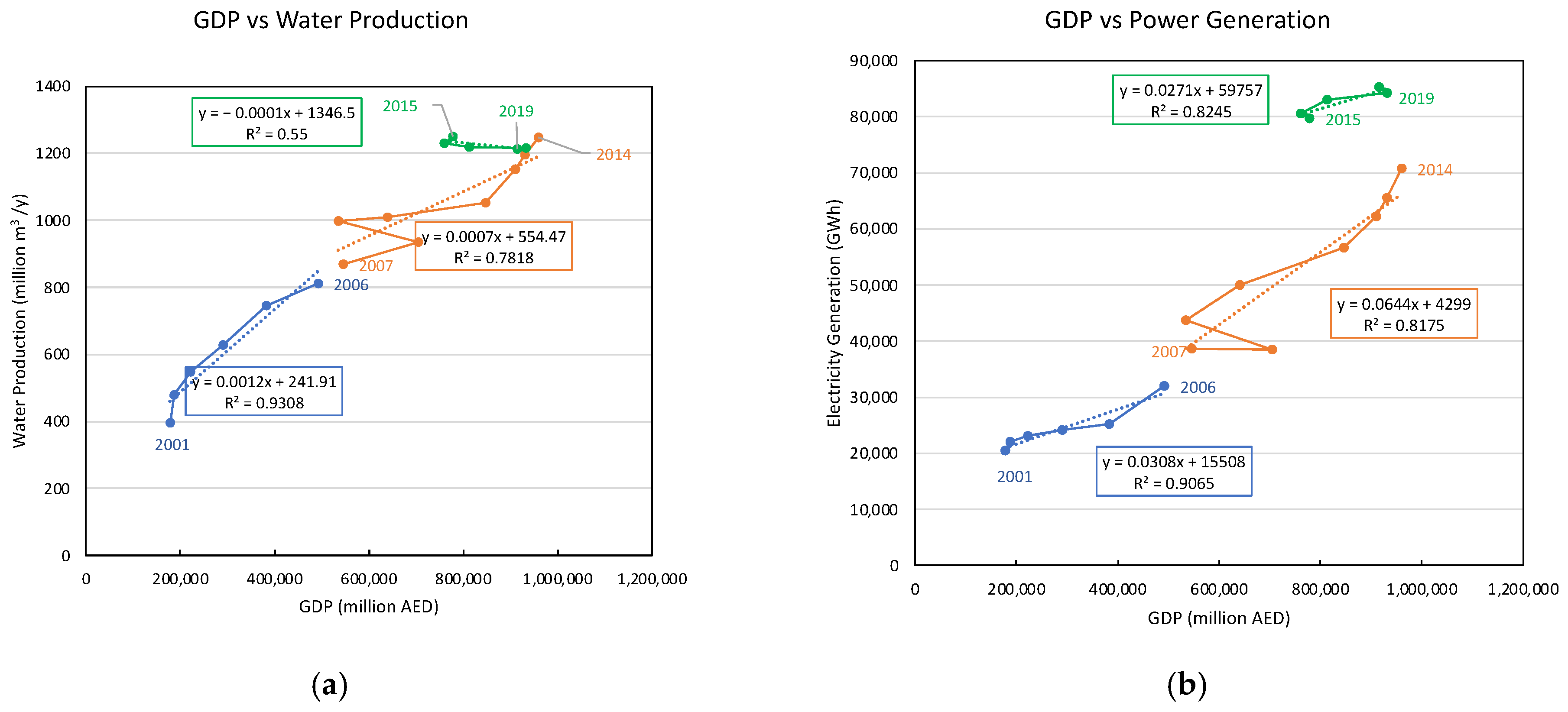
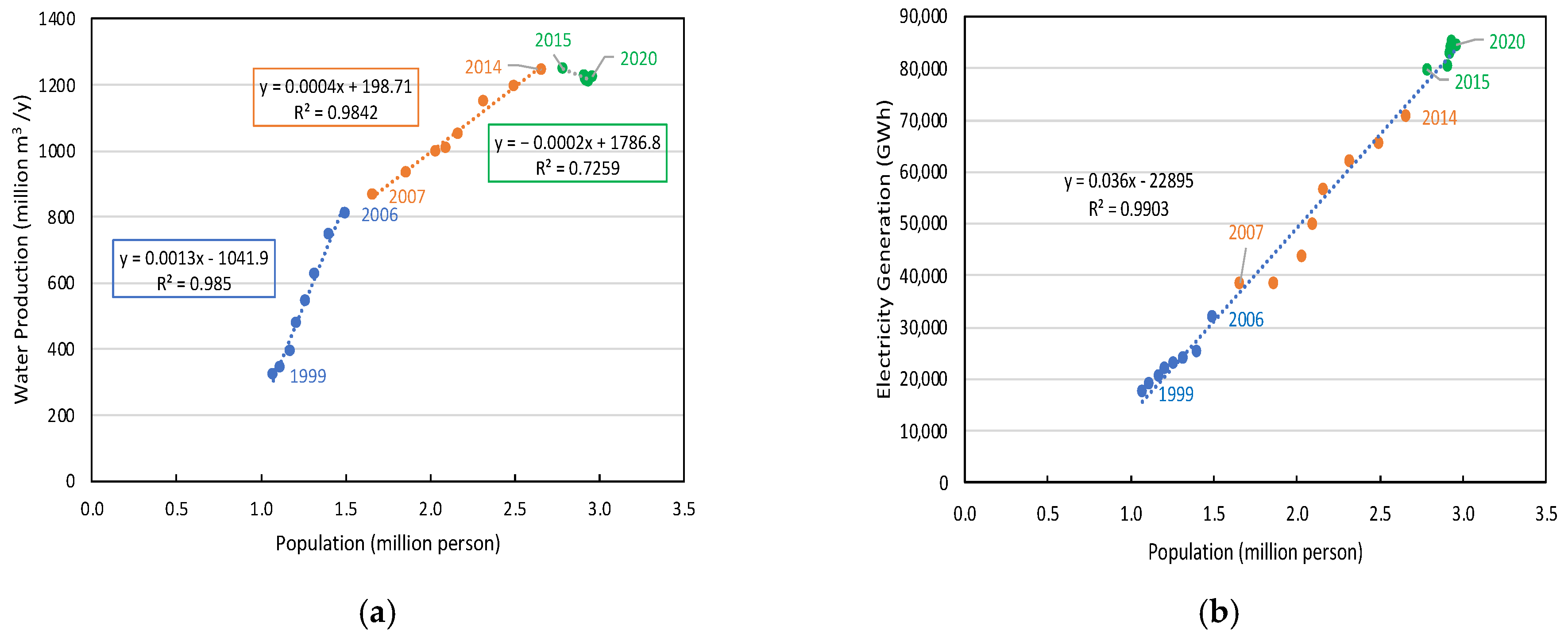
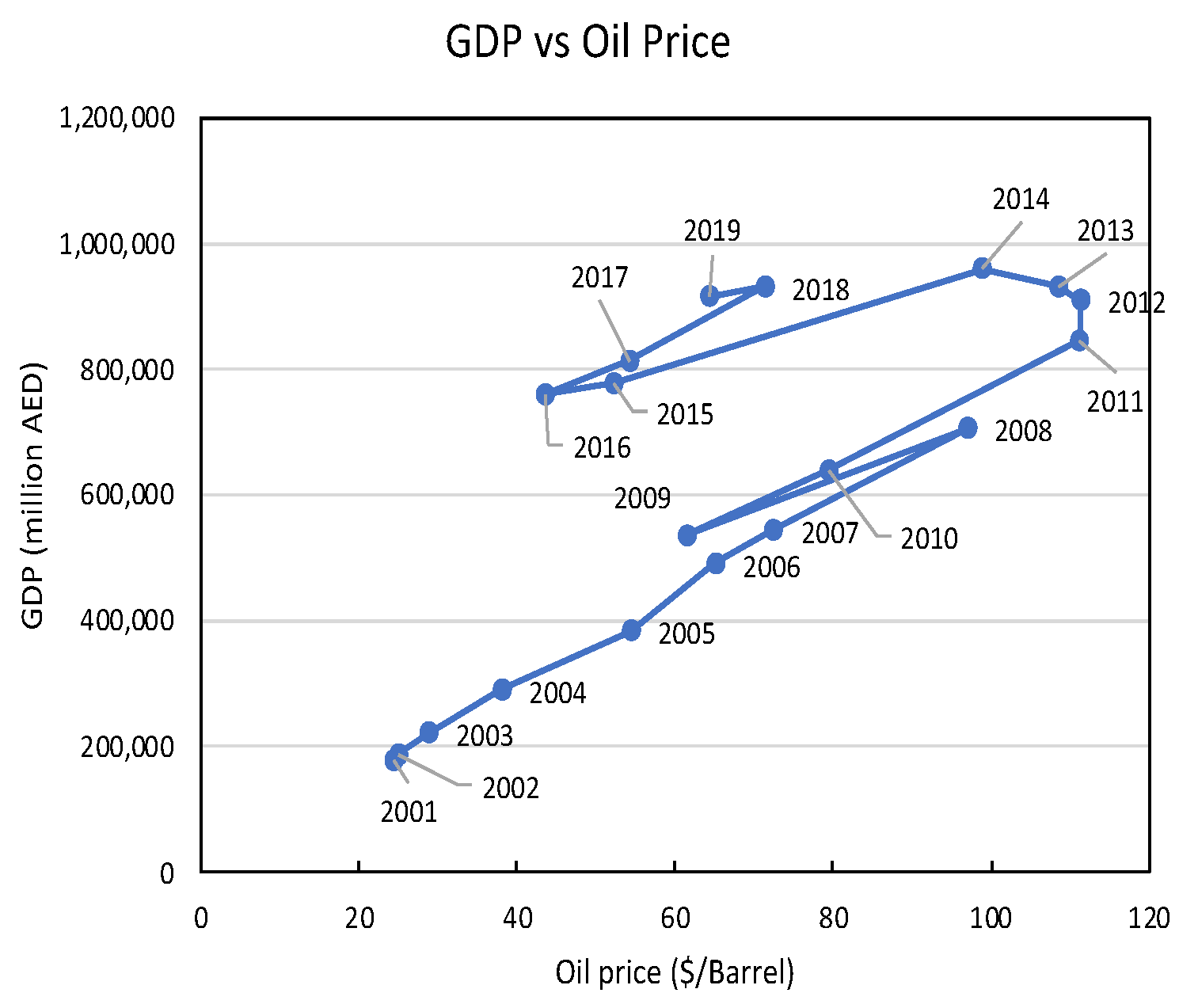
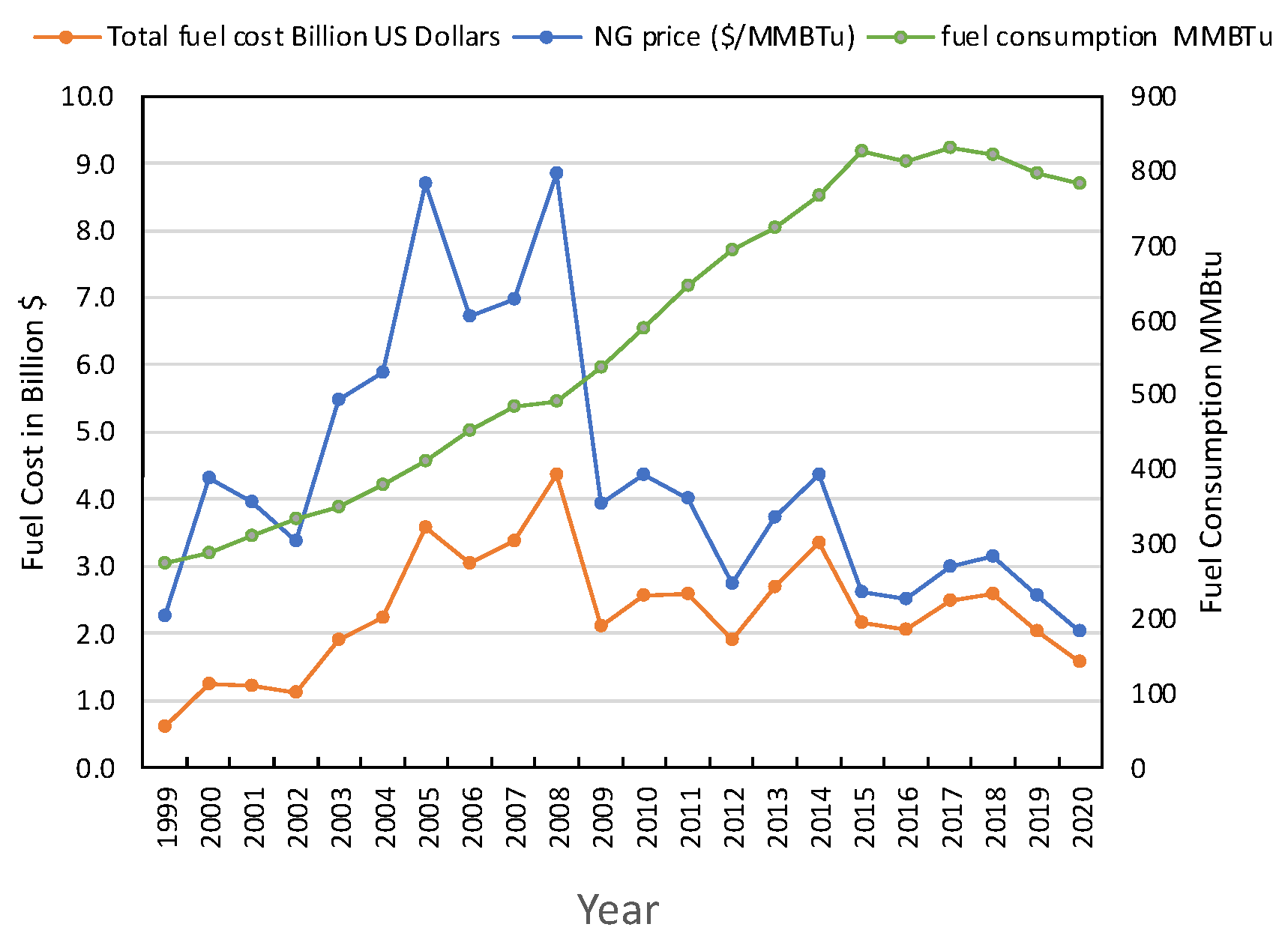
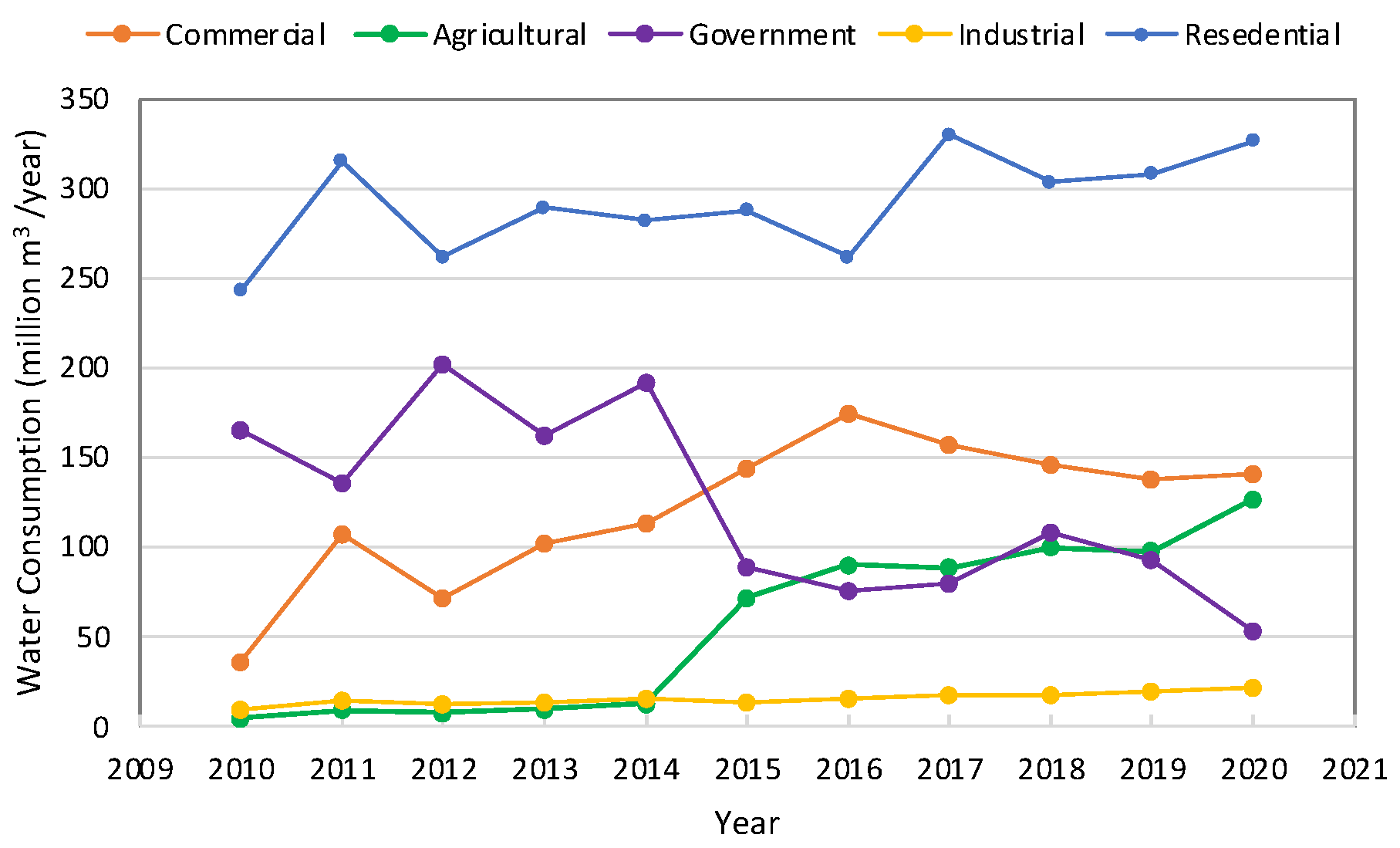
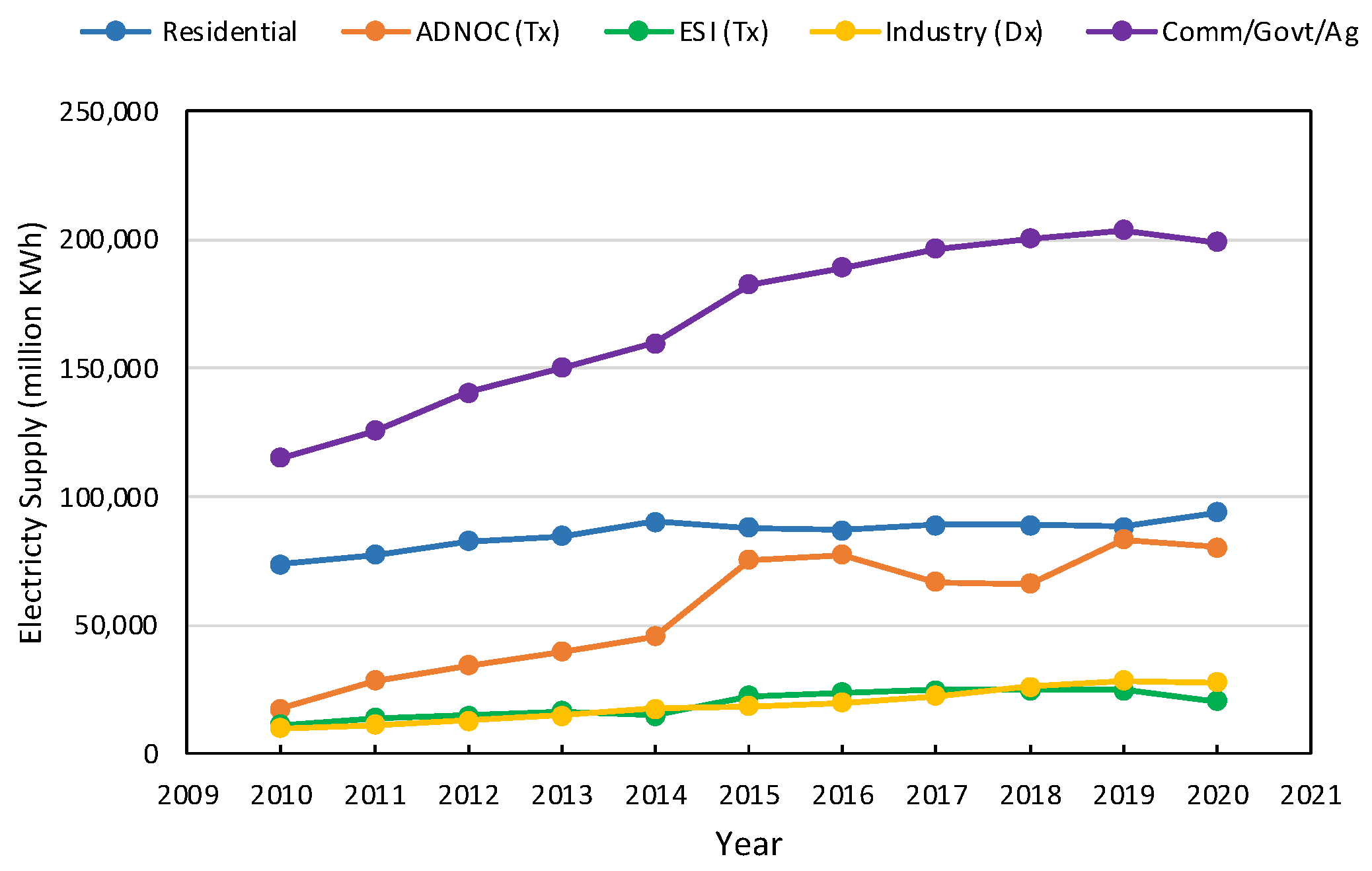

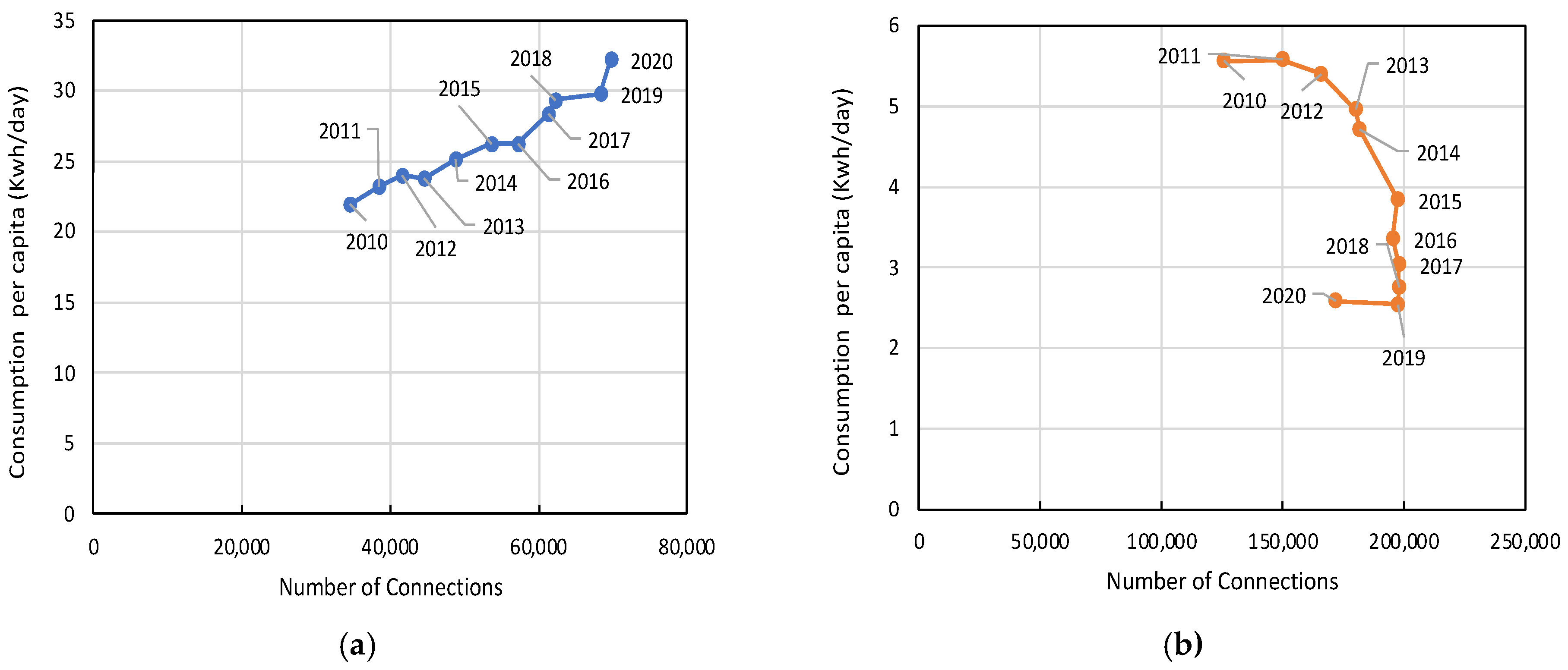
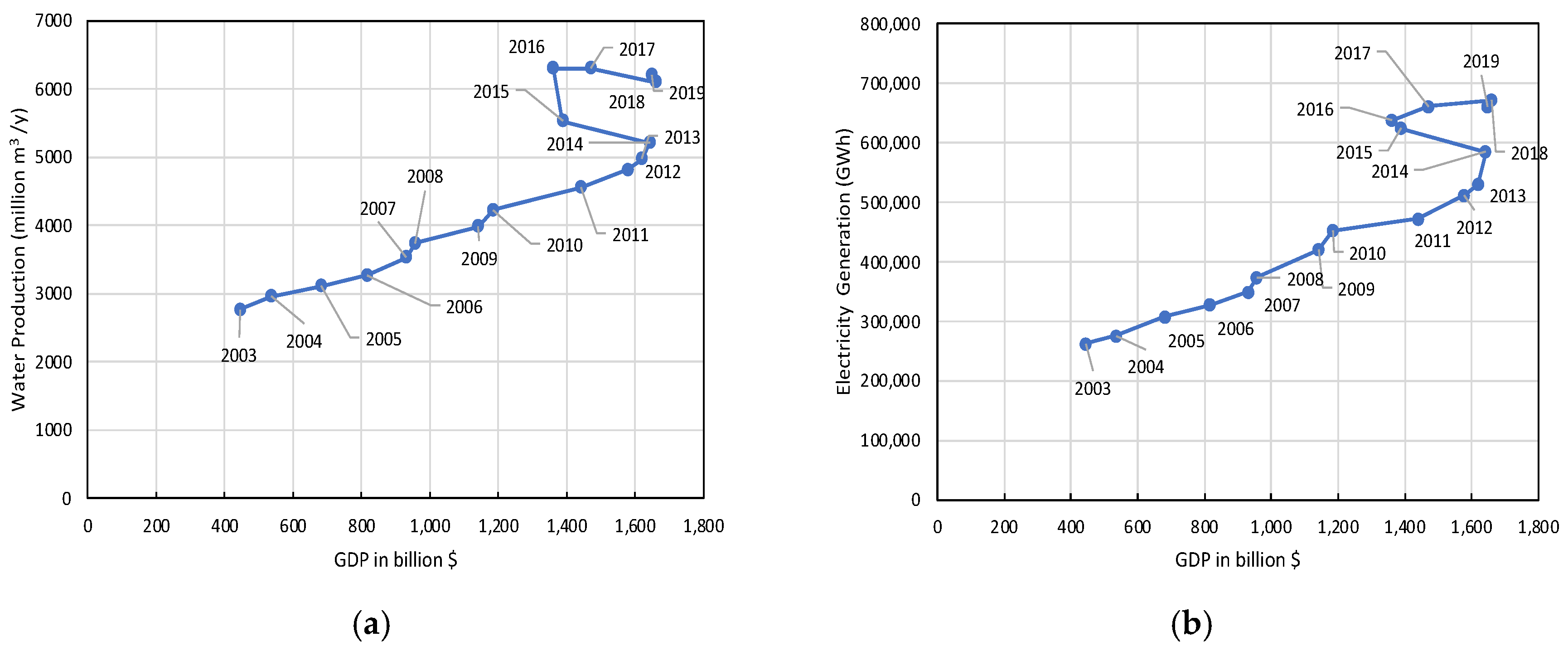

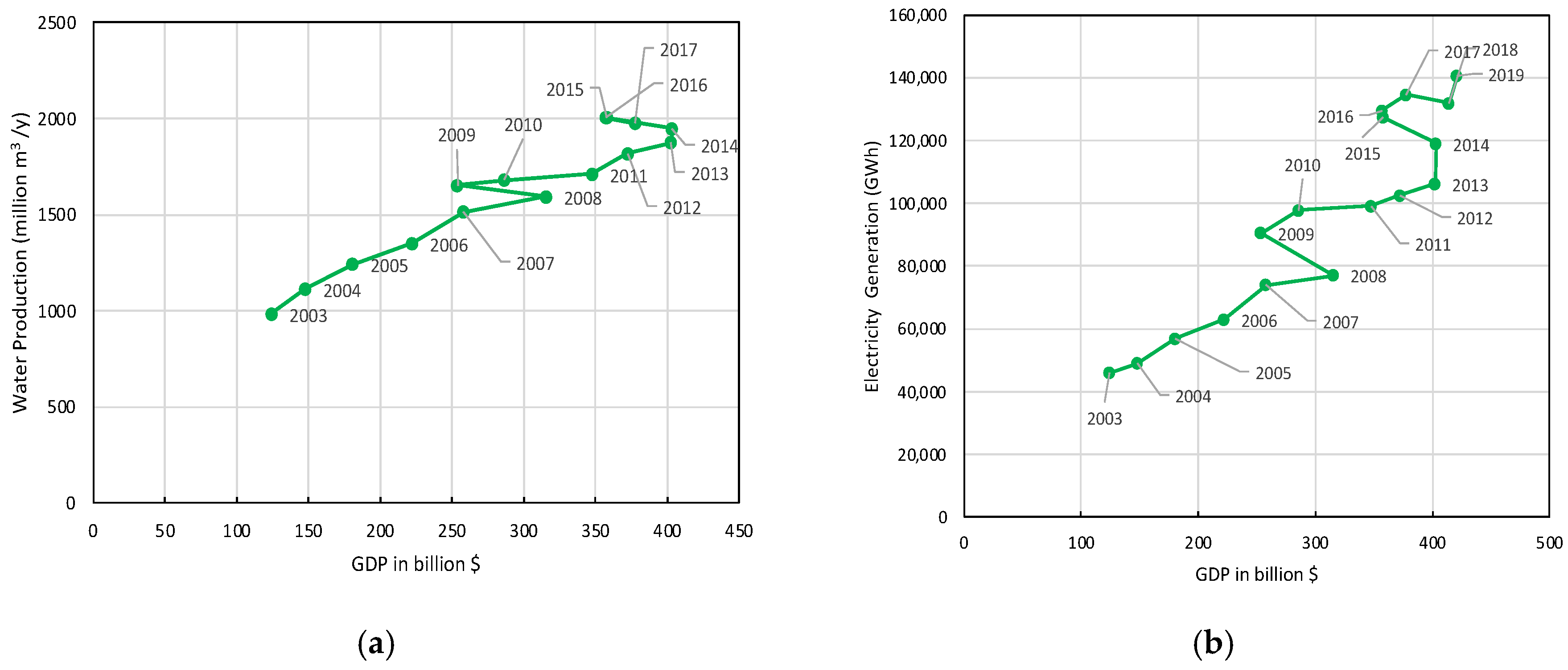
Publisher’s Note: MDPI stays neutral with regard to jurisdictional claims in published maps and institutional affiliations. |
© 2022 by the authors. Licensee MDPI, Basel, Switzerland. This article is an open access article distributed under the terms and conditions of the Creative Commons Attribution (CC BY) license (https://creativecommons.org/licenses/by/4.0/).
Share and Cite
Al Bannay, S.; Takizawa, S. Decoupling of Water Production and Electricity Generation from GDP and Population in the Gulf Cooperation Council (GCC) Countries. Sustainability 2022, 14, 5386. https://doi.org/10.3390/su14095386
Al Bannay S, Takizawa S. Decoupling of Water Production and Electricity Generation from GDP and Population in the Gulf Cooperation Council (GCC) Countries. Sustainability. 2022; 14(9):5386. https://doi.org/10.3390/su14095386
Chicago/Turabian StyleAl Bannay, Shayma, and Satoshi Takizawa. 2022. "Decoupling of Water Production and Electricity Generation from GDP and Population in the Gulf Cooperation Council (GCC) Countries" Sustainability 14, no. 9: 5386. https://doi.org/10.3390/su14095386
APA StyleAl Bannay, S., & Takizawa, S. (2022). Decoupling of Water Production and Electricity Generation from GDP and Population in the Gulf Cooperation Council (GCC) Countries. Sustainability, 14(9), 5386. https://doi.org/10.3390/su14095386







